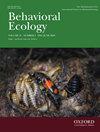Sexually attractive traits predict predation-threat sensitivity of male alternative mating tactics
IF 2.5
3区 环境科学与生态学
Q2 BEHAVIORAL SCIENCES
引用次数: 0
Abstract
Abstract Although visual sexual signals, such as ornamental colors and courtship displays, and large body size in males are attractive to females in numerous species, they may also inadvertently attract the attention of eavesdropping predators and thus may be costly in terms of increasing individual risk of mortality to predation. Theoretically, more color ornamented and larger males should be more predation threat sensitive and suppress their sexual signaling and(or) mating effort relatively more than their less color ornamented and smaller counterparts when under predation hazard. Here, we experimentally tested this hypothesis by quantifying concurrently the rates of alternative mating tactics (courtship displays, sneak mating attempts) expressed by male Trinidadian guppies (Poecilia reticulata) varying in color ornamentation and body size under a staged immediate threat of predation. Males suppressed their overall mating effort in response to the perceived predation threat, decreasing the frequency of their (presumably more conspicuous) courtship displays significantly more on average than the frequency of their sneak mating behavior. Statistically controlling for body length, more color-ornamented males were more threat sensitive in their courtship displays, but not sneak mating attempts, under predation hazard than drabber males. Controlling for body coloration, larger males exhibited lower courtship and sneak mating efforts than smaller males in both predation treatments, but body length only influenced threat sensitivity in sneak mating behavior. These results are consistent with both the threat sensitive hypothesis and asset protection principle and highlight the phenotype dependency and adaptive plasticity of alternative mating tactics in male guppies under varying predation risk.性吸引力特征预测了雄性选择交配策略的捕食威胁敏感性
尽管在许多物种中,雄性的视觉性信号,如装饰性的颜色和求爱的表现,以及大的体型对雌性具有吸引力,但它们也可能无意中引起窃听捕食者的注意,从而可能增加个体被捕食者死亡的风险。从理论上讲,在捕食危险下,与那些颜色装饰较少、体型较小的雄性相比,颜色装饰较多、体型较大的雄性应该对捕食威胁更敏感,并且相对更容易抑制其性信号和(或)交配努力。在这里,我们通过实验验证了这一假设,同时量化了雄性特立尼达孔雀鱼(Poecilia reticulata)在面临捕食威胁的情况下,不同颜色、不同装饰和不同体型的雄性孔雀鱼(Poecilia reticulata)表现出的不同交配策略(求爱、偷袭交配)的比率。雄性在感知到捕食威胁时抑制了它们的整体交配努力,减少了它们(可能更显眼)求爱的频率,平均而言,这比它们偷袭交配行为的频率要明显得多。在控制体长的统计数据上,更多颜色装饰的雄性在求爱时对威胁更敏感,但在捕食危险下,比单调的雄性在偷情时更敏感。在控制身体颜色的情况下,体型较大的雄性在两种捕食处理中都表现出较低的求偶和潜交行为,但体型长度只影响潜交行为的威胁敏感性。这些结果与威胁敏感假说和资产保护原理相一致,突出了不同捕食风险下雄性孔雀鱼选择交配策略的表型依赖性和适应性可塑性。
本文章由计算机程序翻译,如有差异,请以英文原文为准。
求助全文
约1分钟内获得全文
求助全文
来源期刊

Behavioral Ecology
环境科学-动物学
CiteScore
5.20
自引率
8.30%
发文量
93
审稿时长
3.0 months
期刊介绍:
Studies on the whole range of behaving organisms, including plants, invertebrates, vertebrates, and humans, are included.
Behavioral Ecology construes the field in its broadest sense to include 1) the use of ecological and evolutionary processes to explain the occurrence and adaptive significance of behavior patterns; 2) the use of behavioral processes to predict ecological patterns, and 3) empirical, comparative analyses relating behavior to the environment in which it occurs.
 求助内容:
求助内容: 应助结果提醒方式:
应助结果提醒方式:


